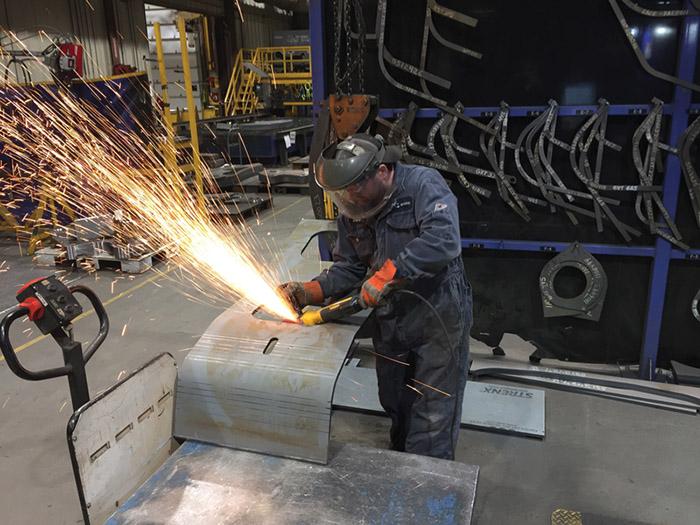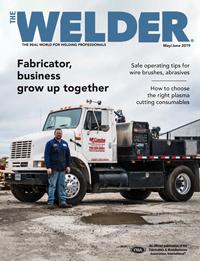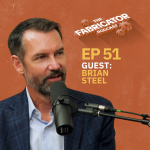District Sales Manager
- FMA
- The Fabricator
- FABTECH
- Canadian Metalworking
Categories
- Additive Manufacturing
- Aluminum Welding
- Arc Welding
- Assembly and Joining
- Automation and Robotics
- Bending and Forming
- Consumables
- Cutting and Weld Prep
- Electric Vehicles
- En Español
- Finishing
- Hydroforming
- Laser Cutting
- Laser Welding
- Machining
- Manufacturing Software
- Materials Handling
- Metals/Materials
- Oxyfuel Cutting
- Plasma Cutting
- Power Tools
- Punching and Other Holemaking
- Roll Forming
- Safety
- Sawing
- Shearing
- Shop Management
- Testing and Measuring
- Tube and Pipe Fabrication
- Tube and Pipe Production
- Waterjet Cutting
Industry Directory
Webcasts
Podcasts
FAB 40
Advertise
Subscribe
Account Login
Search
Safe practices for wire brushes and abrasives
How to minimize the potential for injury
- By Karen Burke and Rick Hopkins
- May 21, 2019
- Article
- Consumables

Following best practices for using wire brushes and abrasive products not only improves safety, it can also deliver more efficient and optimized performance.
Wire brushes and abrasives are highly effective tools for cleaning, deburring, grinding, cutting, and finishing. But with any tool, you must always follow safety requirements and the manufacturer’s recommendations for their use.
One key factor for safe operation is to understand how the products were designed to be used. Following best practices for using wire brushes and abrasives not only improves safety, it can also optimize performance and efficiencies.
Taking advantage of manufacturer training programs that focus specifically on the safe and proper use of these products, while providing education and awareness of the hazards involved, can give you the tools you need to operate wire brushes and abrasives safely.
Safety Training Can Minimize Injuries
Because safety tips and best practices can vary by tool (die grinder, right-angle grinder, or bench grinder) and by product type (bonded abrasives, coated abrasives, and power wire brushes), it’s important to know what the safe operational practices are for each tool and product type.
It’s human nature to do whatever it takes to get the job done. When a product or tool isn’t performing as expected, it’s natural to want to take it upon yourself to adjust form or technique to make the product do the job. But when pushed beyond the conditions of their design, these products can pose danger to you, your co-workers, and the equipment around you.
Reducing the potential for personal injury is always the most important goal. Preventing injuries also saves operations time and money, and using wire brushes and abrasives properly can result in performance and efficiency benefits that impact the bottom line.
Four key factors help ensure safe product operation: speed and size, pressure, orientation, and time (S.P.O.T.).
Factor No. 1: Speed and Size
For safety purposes, you should always match the speed rating and size of the wire brush or abrasive product to the tool. Just because a product fits on a tool doesn’t mean it can be used on that tool safely.

Four key factors that help ensure safe product operation are speed and size, pressure, orientation, and time (S.P.O.T.).
Any tool or product designed for cutting, grinding, or finishing is marked with a maximum RPM rating. For example, a 41⁄2-in. right-angle grinder is typically rated at 11,000 RPM, while a 41⁄2-in. cutting and grinding wheel is typically rated at about 13,000 RPM. The product’s RPM rating should always be equal to or greater than the RPM rating of the tool it’s being used on.
Another common mistake is using a brush, disc, or wheel that is the wrong size for the tool. One example is putting a 6-in. wheel on a 41⁄2-in. grinder. Some may think the larger wheel or disc will provide a deeper cut or longer life, or perhaps it’s the only product on hand. But when accessories don’t fit the tool, they can run out of balance and vibrate excessively, causing loss of control or accessory failure.
As a safety best practice, always keep the guard in place while operating the tool. This prevents using the wrong size accessory on the tool.
Factor No. 2: Pressure
Applying the appropriate pressure and letting the tool do the work plays a huge role in achieving optimal performance.
Abrasive grains dull over time. If you feel the tool isn’t performing as it should, you may respond by applying more pressure. This is counterproductive to product performance and life, as well as safety. Adding extra pressure actually dulls the grains even more, reducing their ability to cut. It also generates heat, which ultimately causes the product to break down more quickly.With wire brushes, applying too much pressure puts stress on the wires and causes the filaments to break, which is a safety hazard that also shortens product life. Light pressure that allows the wire tips to do the work is best when using wire brushes.
One telltale sign that indicates you are using too much pressure is an audible drop in RPM. If you can hear the RPM of the tool drop or hear and feel the motor straining and bogging down, you are likely applying excessive pressure.
The rate of movement across the work surface can also have an impact on performance. This is especially true when using ceramic grains. Fast, choppy strokes typically produce less-than-optimal results, while longer, slower strokes allow the grains to do the work.
Factor No. 3: Orientation
Changing the position and angle of the tool in relation to the workpiece can greatly affect product performance, efficiency, and life.
When using a Type 27 (flat) profile flap disc, for example, use lower grinding angles (5 to 15 degrees) and lighter pressures. When grinding with a Type 29 flap disc for stock removal and aggression, work at an angle of 15 to 35 degrees. Compare that to a cutting wheel or wire wheel, which you should use at a 90-degree angle perpendicular to the part. Varying the position by even a few degrees can put significantly more stress on the wire or abrasive, reducing performance and possibly causing product failure.
Generally speaking, the lower the angle, the slower the cutting but the longer the product life. Conversely, the steeper the grinding angle, the faster the product cuts and wears.
Products are available in varying profiles, which can be helpful for specific applications such as reaching into a tight space or corner.
Factor No. 4: Time
It’s also important to monitor how long you have used the product and to watch for any signs of damage or wear that could pose a safety risk.
Cutting wheels and wire brushes wear down over time, becoming increasingly smaller in diameter. As this happens, you may need to adjust your angle of approach, orientation to the workpiece, and the pressure you apply to compensate for the loss of diameter while maintaining effective cleaning or grinding.
Before using any product, inspect it for rust, corrosion, missing flaps, uneven edge wear, cracks, or chips. Never mount a damaged product, and always inspect it for signs that it has been dropped or damaged. If the product has been dropped—or you suspect it has been dropped—be aware that there could be cracks or chips that aren’t visible.
Time also refers to how long you dwell in one spot on the workpiece. It is important that you minimize that time. Dwelling builds friction and heat, which contribute to the product breaking down faster, which can overheat or damage the workpiece. Be sure to keep the product moving with consistent, controlled strokes.
Proper Storage Is Key
To help optimize performance and extend product life, always store wire brushes and abrasives in a clean and dry location.
Keep in mind, however, that even when products are stored in an appropriate dry location—such as a toolshed—they can still be exposed to significant or extreme changes in temperature and humidity. If this is the case, allow the product to return to ambient temperature before using it for cutting, grinding, or finishing. When a grinding wheel is extremely cold, it can become brittle, and grinding with it immediately can cause wear or failure faster than normal.
Karen Burke is district sales manager and Rick Hopkins is senior product manager at Weiler Abrasives Group, 1 Weiler Drive, Cresco, PA 18326, 570-595-7495, www.weilercorp.com.
5 Basic Tips Before You Get Started
Cutting, grinding, and finishing products are used every day in many metal manufacturing operations. Before you get started, be sure to follow some common safety tips and best practices, including choosing the right tools and wearing the appropriate personal protective equipment (PPE).
- Choose the right product. Before doing any work, make sure you are using the right tool and product configuration for the job.
- Consider the work environment. Take a look around your work area and assess any hazards. A safe work environment begins with a clean, dry floor to prevent slips. Maintain proper ventilation or exhaust systems, and be sure to note the location of the first-aid kit and all wash stations. The area should be well-lit and free of all dust, fumes, and flammable materials. Be aware of potential hazards, including the path which debris will travel when using the product.
- Always wear appropriate PPE. Wearing the right clothing and PPE can reduce the risk of injury. Failing to do so even once increases your injury risk. The minimum protection for cutting, grinding, and finishing includes eye and face protection, hearing protection, long sleeves (that are fire- retardant), gloves on both hands, and an appropriately installed and positioned guard on the tool. An apron is also recommended for cutting and is optional for grinding.
- Jog the tool. Allow the tool to come to a free spin at full speed before using any cutting, grinding, or wire product. To do this, position the tool away from your body and jog it three to four times. ANSI recommends free running grinding and abrasive products for 60 seconds before use. This small step can help protect against a variety of problems that you may not visually see.
- Keep ergonomics in mind. Using correct technique and good ergonomics helps improve efficiency and productivity in addition to safety. For example, clamping the workpiece properly helps minimize vibration and the potential for repetitive strain injury.
About the Authors
Rick Hopkins
Senior Product Manager, Welding and Fabrication
1 Weiler Drive
Cresco, PA, 18326
570-595-7495
About the Publication
subscribe now

The Welder, formerly known as Practical Welding Today, is a showcase of the real people who make the products we use and work with every day. This magazine has served the welding community in North America well for more than 20 years.
start your free subscription- Stay connected from anywhere

Easily access valuable industry resources now with full access to the digital edition of The Fabricator.

Easily access valuable industry resources now with full access to the digital edition of The Welder.

Easily access valuable industry resources now with full access to the digital edition of The Tube and Pipe Journal.
- Podcasting
- Podcast:
- The Fabricator Podcast
- Published:
- 04/09/2024
- Running Time:
- 63:55
In this podcast episode, Brian Steel, CEO of Cadrex Manufacturing, discusses the challenges of acquiring, merging, and integrating...
- Industry Events
16th Annual Safety Conference
- April 30 - May 1, 2024
- Elgin,
Pipe and Tube Conference
- May 21 - 22, 2024
- Omaha, NE
World-Class Roll Forming Workshop
- June 5 - 6, 2024
- Louisville, KY
Advanced Laser Application Workshop
- June 25 - 27, 2024
- Novi, MI































